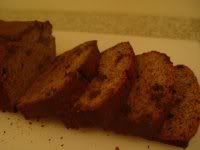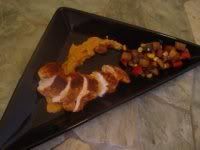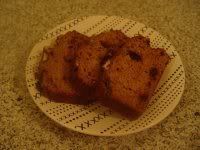
Back when I baked for a living, I formed a theory that the only difference between different quickbreads is the type of pulp used (well, and spices). At the time my brain seemed to think that there was a world of different types of quickbreads, and it held onto that believe until I decided to actually try and prove or disprove it.
The idea was, I would create composite recipes for five different types of quickbreads, and then create a composite recipe based on the composite recipes. The first was easy: pumpkin bread. Banana bread (below) was next. Then I thought I'd try zucchini bread. Then I thought I'd try... um... what was another kind of quick bread? Wasn't there... um. Well, there was... er... gee, what other quickbreads are there?
It was time to hit Google. After a few searches, I had found recipes for pear bread (but oddly, no apple bread) and for Boston brown bread. The pear bread recipes seemed pretty close to the pumpkin, banana and zucchini bread recipes. The brown bread recipes seemed fond of cornmeal, which takes them out of my quickbread theory. Everything else still seems (at a glance) to fit, though I obviously haven't finished my comparisons yet.
The banana bread recipe that I came up with did seem really close to the pumpkin bread recipe. Take a look:
| Ingredients | Recipe 1 | Recipe 2 | Recipe 3 | Recipe 4 | Recipe 5 | Recipe 6 | Me |
| oven temp | 350F | 350F | 350F | 350F | 325F | 325F | 350F |
| bake time | 1 hr | 60 – 65 min | 45 – 60 min | 55 – 60 min | 50 – 60 min | 1 hr 10 min | 50 – 60 min |
| ap flour | 3 cups | 4 cups | 2 1/4 cups | 3 1/2 cups | 1 1/4 cups | 4 cups | 3 1/2 cups |
| ww pastry flour | 1 cup | ||||||
| baking soda | 2 tsp | 2 tsp | 2 tsp | 1/2 tsp | 1 tsp | 2 tsp | 2 tsp |
| baking powder | 2 tsp | 4 tsp | 2 tsp | 2 tsp | |||
| salt | 1/4 tsp | 1/2 tsp | 1 tsp | 1/2 tsp | 1 tsp | 2 tsp | 1 tsp |
| cinnamon | 2 tsp | 2 tsp | 1 tsp | 2 tsp | 2 tsp | ||
| cloves | 1 tsp | 1 tsp | |||||
| nutmeg | 1 tsp | 1 tsp | |||||
| bananas | 6 – 8 ea | 2 1/3 cups | 6 ea | 6 ea (3 cups) | 5 ea | 6 ea | 6 ea |
| butter | 2/3 cup | 1 cup | 1 cup | 1 cup | 1 cup | 1 cup | |
| shortening | 1 cup | ||||||
| sugar | 1 1/2 – 2 cups | 2 cups | 1 1/2 cups | 1 cup | 2 cups | 1 1/2 cups | |
| brown sugar | 1 1/2 cup | ||||||
| eggs | 2 ea | 4 ea | 4 ea | 4 ea | 4 ea | 4 ea | 4 ea |
| vanilla | 2 tsp | 2 tsp | 2 tsp | 2 tsp | |||
| milk | 2 Tbsp | ||||||
| nuts | 1 cup | 2 cups | |||||
| banana garnish | 1 lg banana | ||||||
| method | muffin (kind of) | creaming (kind of) | creaming | muffin | muffin | creaming | muffin |
Again, any recipes that were not already for 2 loaves were converted. I looked at mixing methods again this time, and was surprised to find that some recipes used a creaming method instead of a muffin method. Interesting that that didn't happen with the pumpkin bread. But not surprisingly, some of the mixing methods varied enough that I had a hard categorizing them. Welcome to the Internet.
The thing that kind of threw me was the flour. I ended up with 3 1/2 cups instead of 3 cups. I thought about just using 3 cups, which would put it more in line with my pumpkin bread, but I thought I'd keep myself honest and leave it at what seemed like a reasonable comparison with just the other banana breads.
Rather than mushing up the bananas, I got lazy and tossed them in the food processor. That just about liquified them, but it did give me an even consistency that the pumpkin puree had, and that mashed up bananas wouldn't have. The bananas seemed more liquid than the pumpkin, so I thought that maybe the extra 1/2 cup of flour really was accurate. But in the end, that didn't seem to be the case. Still-warm-from-the-oven slices of banana bread were okay, but once it cooled it just seemed a little dry to me. I don't know that dropping all the way to 3 cups is right, but maybe 3 1/4 cups would be more appropriate.
Speaking of liquid, this recipe had something the pumpkin bread didn't: vanilla extract. In retrospect, I think that while it would be a compatible flavor with both, it works far better with banana. And did you notice how the first recipe calls for more bananas, but fewer eggs? Maybe not a bad way to introduce extra flavor, without throwing off the moisture ratio.
The other major difference between these two recipes is leavening. Baking soda vs baking powder. As per the recipes, I went with just soda on the pumpkin bread, but both in the banana bread. Part of me wants to look up acidity values for pumpkin vs banana and do some maths, but the part of me that's too lazy to do so has so far been much more convincing.
Spices varied a little, but not much. By and large it seemed that most people were only interested in cinnamon, but a couple added cloves and nutmeg. I kind of liked the idea of adding those two extras, so I went with them. After tasting the batter, I thought that I might want to halve the amount of clove, but I didn't really pick up the nutmeg. But I think something might have been lost without it. It just had that extra non-cinnamon spiciness that my my tasters this time around (I brought a loaf to class to share with my students) seemed to enjoy. They especially loved the clove however, which was somewhat subdued after the baking.
It was interesting to note the garnishes that people came up with. One person went with a lot of nuts, as well as dried banana chips. For my part, I went with semisweet chocolate chips. My tasters really dug those. A couple of people said they provided a really nice balance.
A final thought on this recipe. While the bananas were added in mostly as mush, not all of them got cut up completely. There were a couple of chunks, and when I hit them, they added extra flavor and moistness to the bite. This tells me that either I should go with mashed, rather than pureed bananas, or I should drop the flour and/or add more banana to it. I'm voting for dropping the flour, but I might try mashed next time around.





